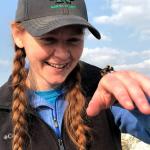The 2020 survey season begins this June. We hope you’ll join us in our quest to learn more about bumble bees and restore Nebraska’s natural habitats.
Walking around Nebraska prairies in the summer of 2019, you might have been lucky enough to witness large groups of people swinging bug nets, and wondered what they were doing with such great enthusiasm. These community scientists—members of our community with any level of scientific experience—were learning how to participate in the Nebraska Bumble Bee Atlas.
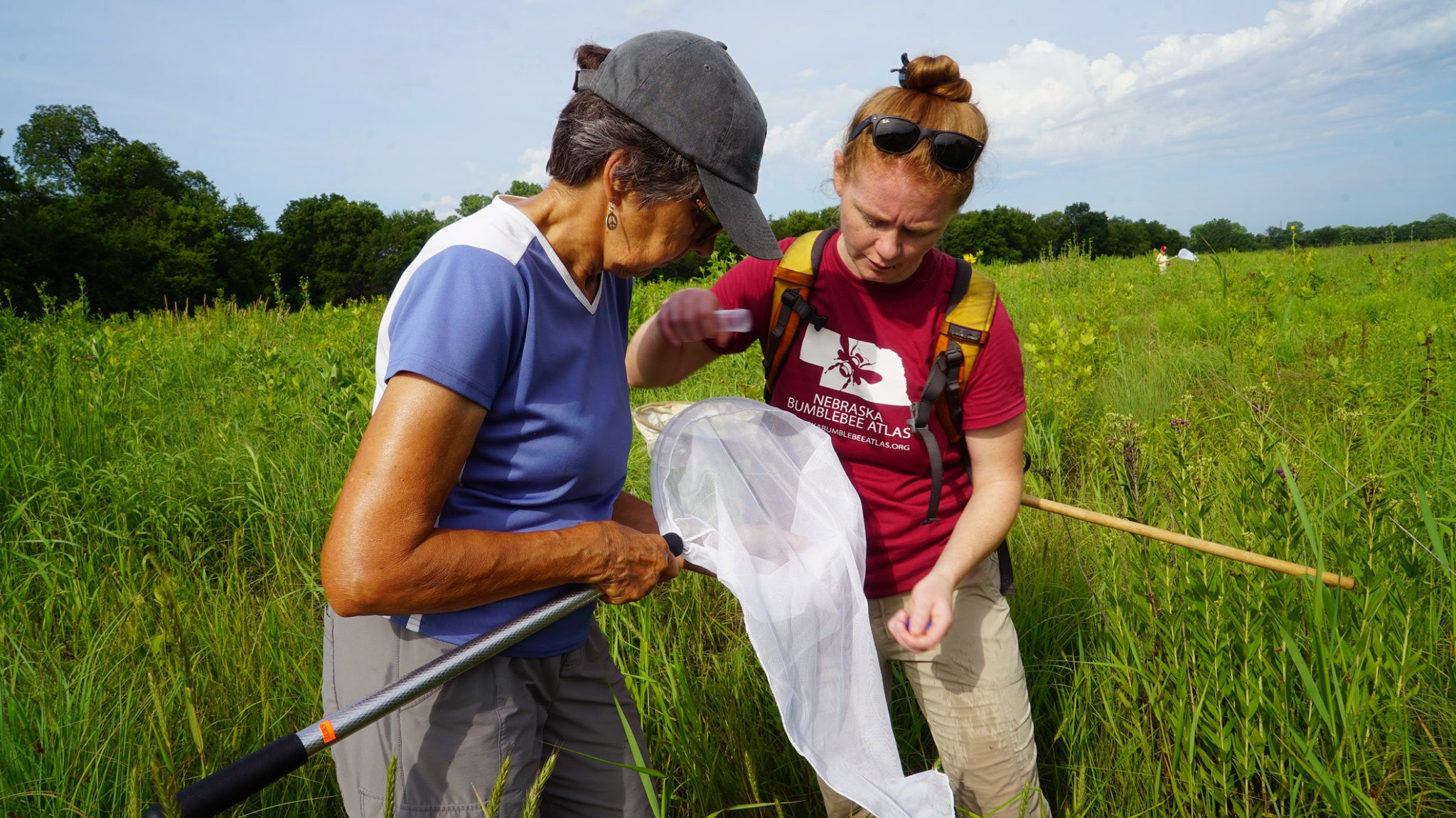
By volunteering for the Nebraska Bumble Bee Atlas, you'll be contributing to a collaborative effort aimed at tracking and conserving Nebraska’s native bumble bees. In this image, the author (right) conducting a workshop in 2019. (Photo: Kat Scholl)
The Atlas is a collaborative effort aimed at tracking and conserving Nebraska’s native bumble bees. Supported by the Nebraska Environmental Trust, researchers at the University of Nebraska-Lincoln and the Xerces Society have teamed up to organize and mobilize this statewide effort, and are encouraging everyone that lives in or near Nebraska to participate.
Nebraska is home to approximately 20 different species of bumble bees, all of which play an important role in sustaining the health of our environment. The pollination services that bees provide help to maintain ecological balance in natural and urban areas and contribute to successful harvests on farms.
Unfortunately, many species of bumble bees face an uncertain future and need our help. A status review by Dr. Robbin Thorp and the Xerces Society, as well as research led by Dr. Sydney Cameron, has demonstrated that one-fourth of North America’s nearly 50 species of bumble bees are undergoing dramatic population declines.
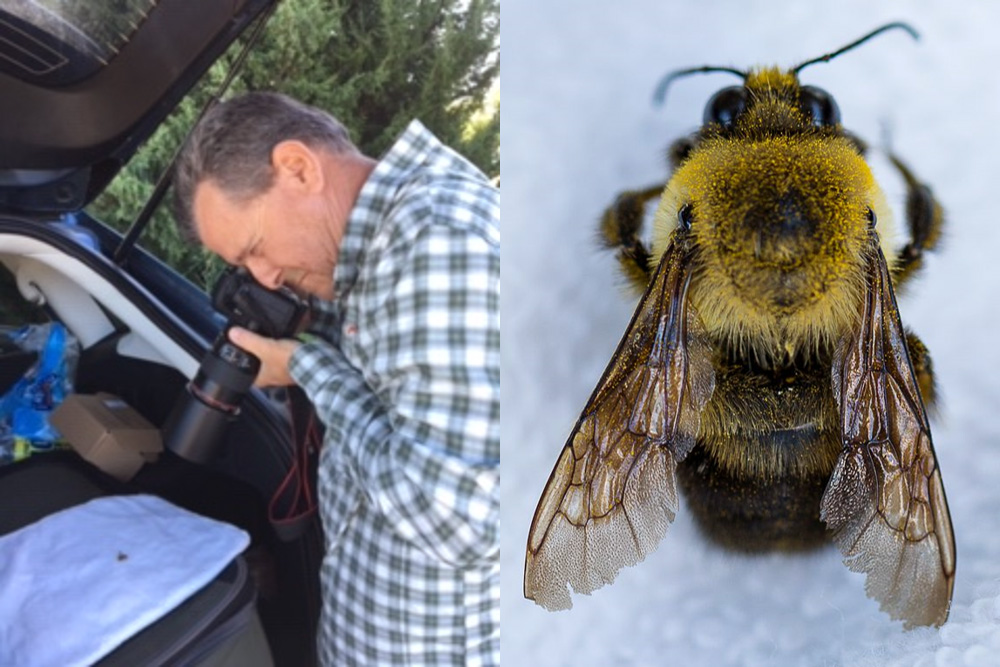
Nebraska Bumble Bee Atlas volunteer Ted Kyster photographs a brown-belted bumble bee (Bombus griseocollis). (Photo, left: Denise Pecha. Photo, right: Ted Kyster)
The causes of these declines are not fully understood, but the following are likely factors: Habitat loss, pesticide use, climate change, low genetic diversity, and the introduction and distribution of pathogens through commercial pollinators. Although more study is needed on the cause of bumble bee declines, we know that protecting, restoring, and managing existing habitat are some of the most immediate and productive steps we can take to conserve these important pollinators. That’s where community science projects like the Nebraska Bumble Bee Atlas can help.
Community science (sometimes called “citizen science” or “participatory science”) occurs when researchers invite the general public to contribute to their science project. The level of investment varies, as does the way in which people engage with the project—from independently observing wildlife in the field, to contributing work online.
Community science has grown in popularity because of the immense value it provides for everyone involved. Engaging the general public in science projects accelerates our ability to collect more data, across a greater area, than one could do alone or as a small team. Community members get to contribute to a cause they care about, while their knowledge of, and engagement with, a particular science topic grows substantially. This may be the most valuable aspect of community science, because it builds a vast network of advocates that go on to raise awareness for important species or causes.
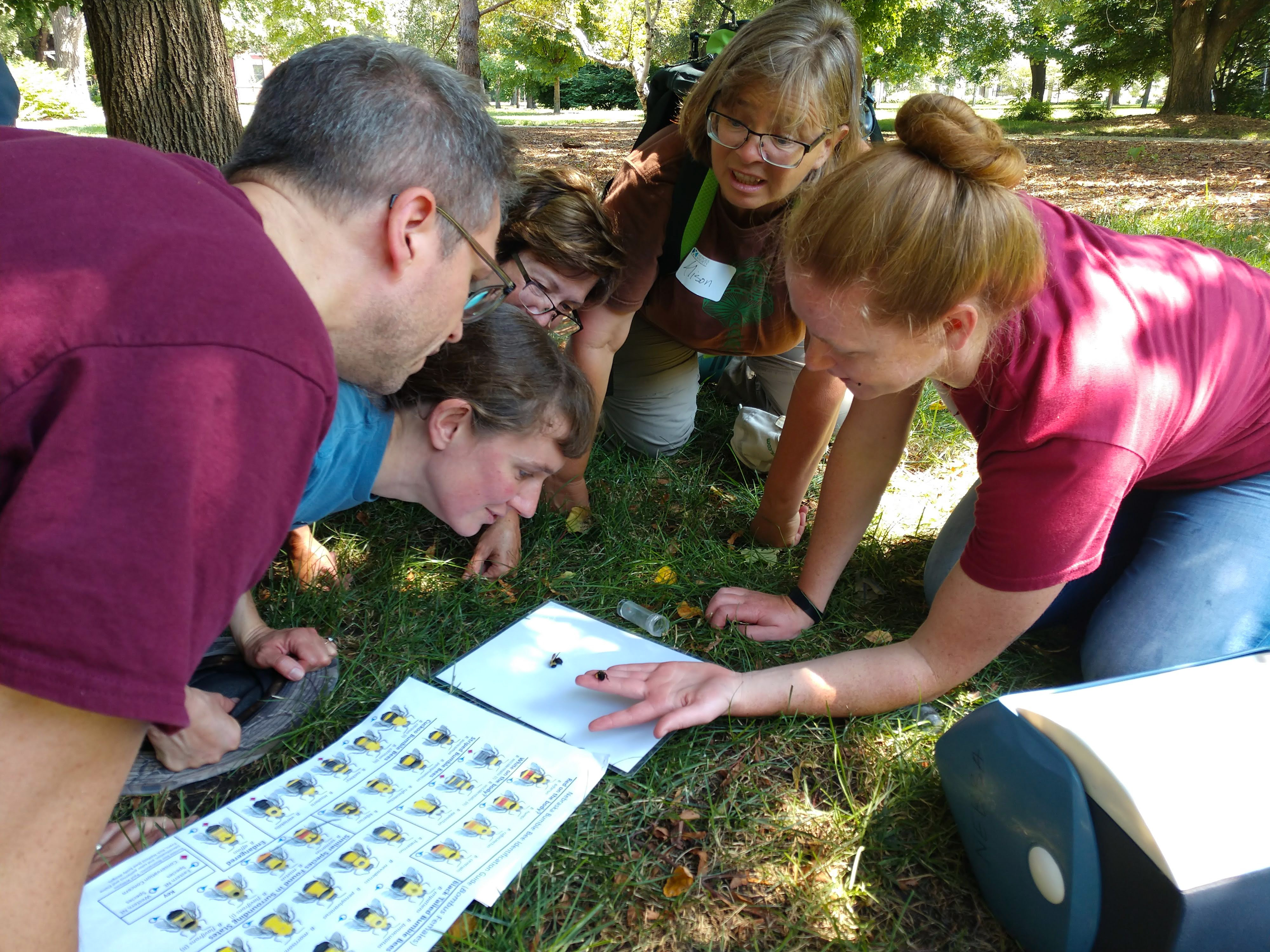
The author conducts a Nebraska Bumble Bee Atlas workshop in 2019. Community science efforts like the Atlas build community and interest in bumble bees while also furthering scientific research and conservation efforts. (Photo: Mercy Manzaneres)
Two such advocates are Ted Kyster and Denise Pecha, both of whom are preparing for their second year as Nebraska Bumble Bee Atlas volunteers. For them, taking part in community science efforts is valuable because they serve as opportunities to help take care of our natural world, and create an avenue for encouraging friends and family to do the same.
“We love the discovery and ‘wondery’ of it all,” said Pecha. “We just kept learning and participating in local nature activities, and the more you learn, the more you want to do!”
Kyster and Pecha have participated in global efforts like iNaturalist, North American projects such as Journey North, as well as numerous localized efforts like Nebraska Wildlife Watch.
“Community science projects have deepened our love for the prairie and the state we call home,” Kyster explained. “And we have made many new friends as we explore, discover, and share with others.”
The Atlas’s first round of educational workshops occurred in eastern Nebraska in 2019, and they equipped participants with the necessary skills, knowledge and confidence to run bumble bee surveys independently. These workshops were well-received, to say the least: 70% of the 100 attendees registered to participate!
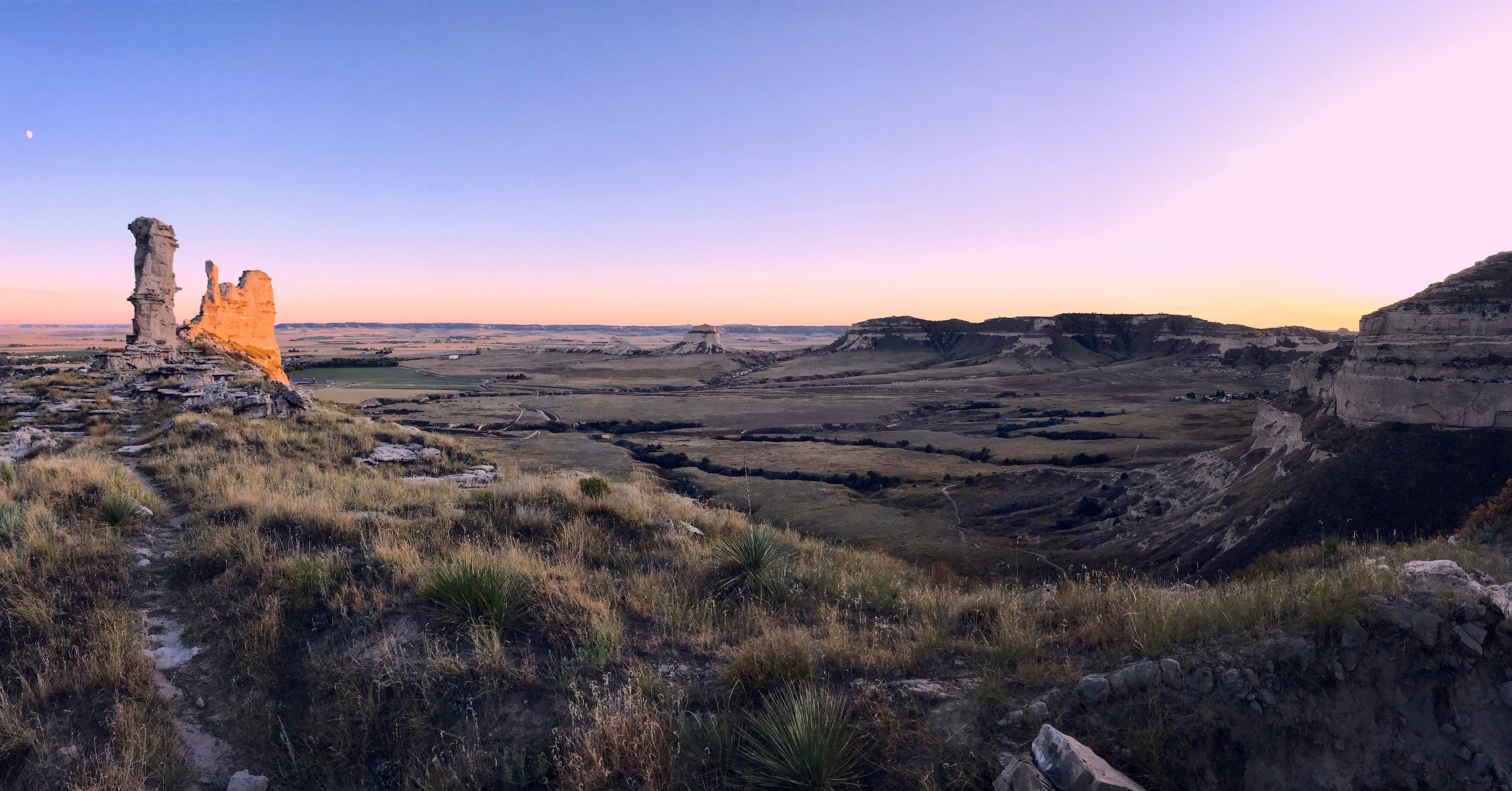
Scotts Bluff National Monument, in western Nebraska. One of the perks of taking part in the Nebraska Bumble Bee Atlas is exploring new territory. (Photo: Xerces Society / Katie Lamke)
When people register for the project, they adopt a grid cell, taking on the responsibility of surveying a particular area of Nebraska. This ensures that all areas of the state receive equal attention. Kyster and Pecha found the first season so enjoyable that they adopted four additional grid cells to survey in the upcoming 2020 season, set to start in June. The pair hopes to observe species that didn’t appear in their 2019 surveys and potentially detect some of the state’s less common species, such as the at-risk western bumble bee (Bombus occidentalis). This of course comes with an added bonus of getting to admire and explore the pure beauty of Nebraska’s diverse ecoregions like the Sandhills and Shortgrass prairies.
For those of you wondering, no bees are harmed in this project: Everything is catch-and-release. During a survey, community scientists take high-quality photographs of all the bees they observe. These photographs are then submitted online through Bumble Bee Watch and the identifications are verified by experts. If you’d like to submit your own photo observations of bumble bees, simply download the Android or Apple mobile app, or refer to the Bumble Bee Watch website.
In 2019, Atlas participants observed 670 individual bumble bees of 11 different species, and submitted associated habitat data for 30% of the project’s total grid cells in Nebraska. The habitat data provides researchers with a snapshot of the landscape: Type and amount of blooming flowers, insight on management practices like burning or grazing, presence of nesting habitat, and an overall classification of the survey area (whether it is urban, natural, or agricultural).
This type of information is essential for improving our understanding of bumble bees, and allows researchers to form evidence-based recommendations that will help guide the work of land managers, conservation practitioners, and policy-makers. For example, the data may allude to pockets in Nebraska that support healthy populations of the southern Plains bumble bee (Bombus fraternus), a Species of Greatest Conservation Need, which will help the Nebraska Game and Parks Commission refine their conservation actions.
The 2020 survey season begins this June. We hope you’ll join us in our quest to learn more about bumble bees and restore Nebraska’s natural habitats. Our 2020 goal is to expand into central and western Nebraska, and focus our collective survey effort in grid cells that were untouched in 2019 (see map).
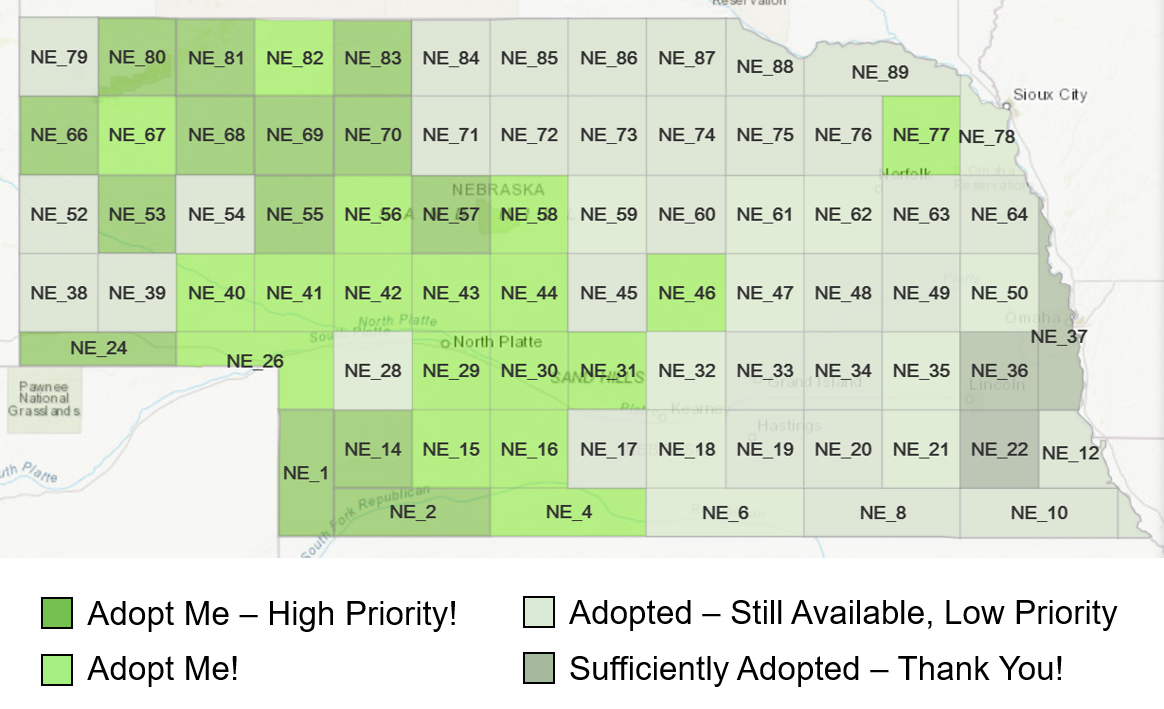
This map shows the high priority areas for the 2020 Nebraska Bumble Bee Atlas survey season.
Due to the current state of affairs with the coronavirus, it is uncertain if our in-person workshops will take place this year. However, our Online Training Portal is open to everyone who wants to participate. You can watch a series of video modules, download and read the Participant Handbook, and otherwise prepare remotely. Come June, it will hopefully still be possible to explore the outdoors and conduct bumble bee surveys while maintaining physical distancing.
To conclude, this Earth Week, remember that we are all scientists. Science is about curiosity and setting out to explore, question and observe the world around us. Whether you join the Nebraska Bumble Bee Atlas or a project closer to home, go forth with the words of Ted Kyster: “Find your way of doing a little to impact the whole.” The Earth will thank you for it.
The Nebraska Bumble Bee Atlas is supported by the Nebraska Environmental Trust. The Trust is funded by proceeds from the Nebraska Lottery and has awarded more than $320 million to more than 2,100 conservation projects across the state of Nebraska since 1994.
Further Reading
Visit our website for more results and photographs from the 2019 survey season.
Learn more about bumble bee community science efforts in Nebraska and beyond:
- Bumble Bee Watch.
- Nebraska Bumble Bee Atlas.
- Nebraska Master Naturalist Program.
- Citizen Scientists of Nebraska.
- Pacific Northwest Bumble Bee Atlas.
Check out all the community science listings on the Xerces Society website.
Read the rest of our Earth Week content!

